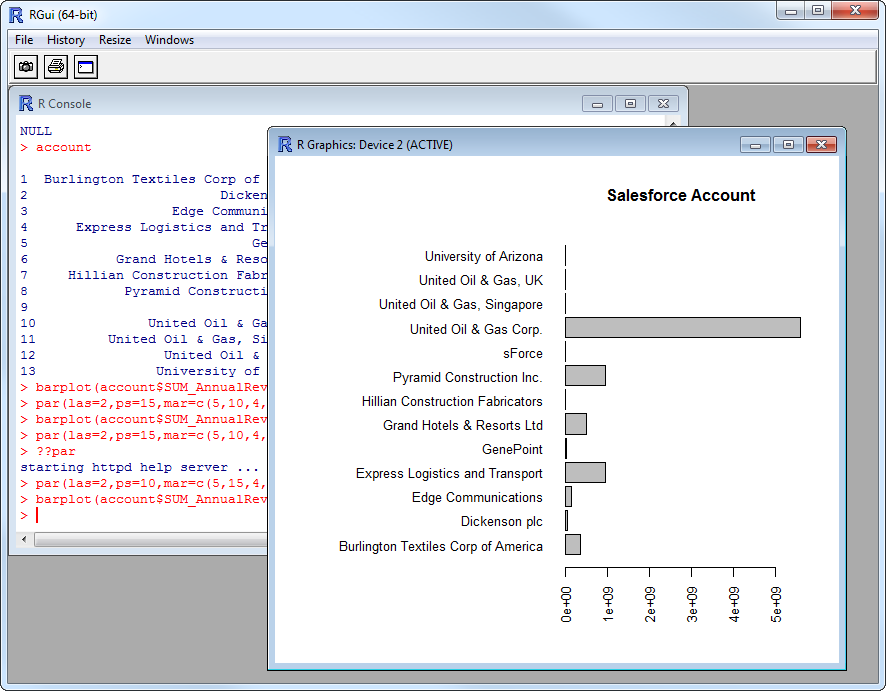Discover how a bimodal integration strategy can address the major data management challenges facing your organization today.
Get the Report →Analyze SAP SuccessFactors Data in R
Use standard R functions and the development environment of your choice to analyze SAP SuccessFactors data with the CData JDBC Driver for SAP SuccessFactors.
Access SAP SuccessFactors data with pure R script and standard SQL on any machine where R and Java can be installed. You can use the CData JDBC Driver for SAP SuccessFactors and the RJDBC package to work with remote SAP SuccessFactors data in R. By using the CData Driver, you are leveraging a driver written for industry-proven standards to access your data in the popular, open-source R language. This article shows how to use the driver to execute SQL queries to SAP SuccessFactors and visualize SAP SuccessFactors data by calling standard R functions.
Install R
You can match the driver's performance gains from multi-threading and managed code by running the multithreaded Microsoft R Open or by running open R linked with the BLAS/LAPACK libraries. This article uses Microsoft R Open 3.2.3, which is preconfigured to install packages from the Jan. 1, 2016 snapshot of the CRAN repository. This snapshot ensures reproducibility.
Load the RJDBC Package
To use the driver, download the RJDBC package. After installing the RJDBC package, the following line loads the package:
library(RJDBC)
Connect to SAP SuccessFactors as a JDBC Data Source
You will need the following information to connect to SAP SuccessFactors as a JDBC data source:
- Driver Class: Set this to cdata.jdbc.sapsuccessfactors.SAPSuccessFactorsDriver
- Classpath: Set this to the location of the driver JAR. By default this is the lib subfolder of the installation folder.
The DBI functions, such as dbConnect and dbSendQuery, provide a unified interface for writing data access code in R. Use the following line to initialize a DBI driver that can make JDBC requests to the CData JDBC Driver for SAP SuccessFactors:
driver <- JDBC(driverClass = "cdata.jdbc.sapsuccessfactors.SAPSuccessFactorsDriver", classPath = "MyInstallationDir\lib\cdata.jdbc.sapsuccessfactors.jar", identifier.quote = "'")
You can now use DBI functions to connect to SAP SuccessFactors and execute SQL queries. Initialize the JDBC connection with the dbConnect function.
You can authenticate to SAP Success Factors using Basic authentication or OAuth with SAML assertion.
Basic Authentication
You must provide values for the following properties to successfully authenticate to SAP Success Factors. Note that the provider will reuse the session opened by SAP Success Factors using cookies. Which means that your credentials will be used only on the first request to open the session. After that, cookies returned from SAP Success Factors will be used for authentication.
- Url: set this to the URL of the server hosting Success Factors. Some of the servers are listed in the SAP support documentation (external link).
- User: set this to the username of your account.
- Password: set this to the password of your account.
- CompanyId: set this to the unique identifier of your company.
OAuth Authentication
You must provide values for the following properties, which will be used to get the access token.
- Url: set this to the URL of the server hosting Success Factors. Some of the servers are listed in the SAP support documentation (external link).
- User: set this to the username of your account.
- CompanyId: set this to the unique identifier of your company.
- OAuthClientId: set this to the API Key that was generated in API Center.
- OAuthClientSecret: the X.509 private key used to sign SAML assertion. The private key can be found in the certificate you downloaded in Registering your OAuth Client Application.
- InitiateOAuth: set this to GETANDREFRESH.
Built-in Connection String Designer
For assistance in constructing the JDBC URL, use the connection string designer built into the SAP SuccessFactors JDBC Driver. Either double-click the JAR file or execute the jar file from the command-line.
java -jar cdata.jdbc.sapsuccessfactors.jar
Fill in the connection properties and copy the connection string to the clipboard.

Below is a sample dbConnect call, including a typical JDBC connection string:
conn <- dbConnect(driver,"jdbc:sapsuccessfactors:User=username;Password=password;CompanyId=CompanyId;Url=https://api4.successfactors.com;")
Schema Discovery
The driver models SAP SuccessFactors APIs as relational tables, views, and stored procedures. Use the following line to retrieve the list of tables:
dbListTables(conn)
Execute SQL Queries
You can use the dbGetQuery function to execute any SQL query supported by the SAP SuccessFactors API:
extaddressinfo <- dbGetQuery(conn,"SELECT address1, zipCode FROM ExtAddressInfo WHERE city = 'Springfield'")
You can view the results in a data viewer window with the following command:
View(extaddressinfo)
Plot SAP SuccessFactors Data
You can now analyze SAP SuccessFactors data with any of the data visualization packages available in the CRAN repository. You can create simple bar plots with the built-in bar plot function:
par(las=2,ps=10,mar=c(5,15,4,2))
barplot(extaddressinfo$zipCode, main="SAP SuccessFactors ExtAddressInfo", names.arg = extaddressinfo$address1, horiz=TRUE)







